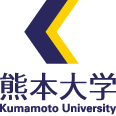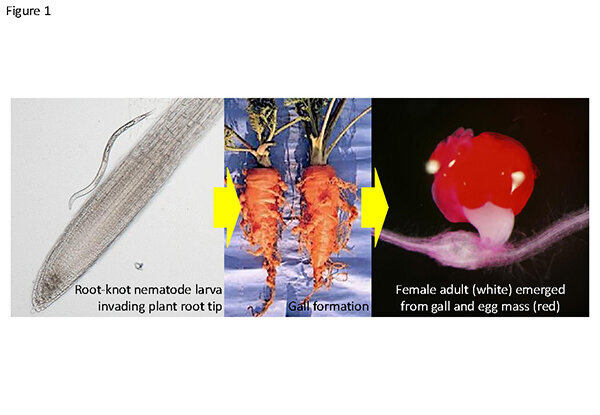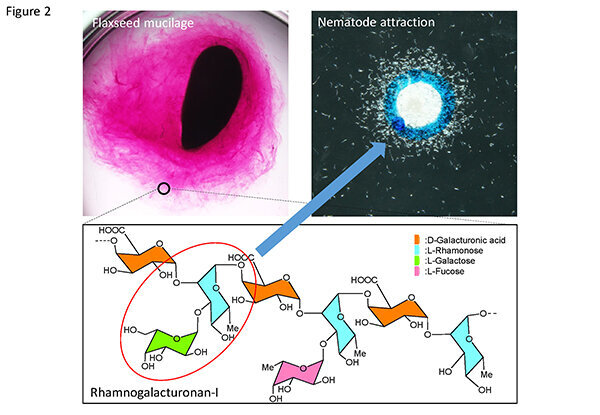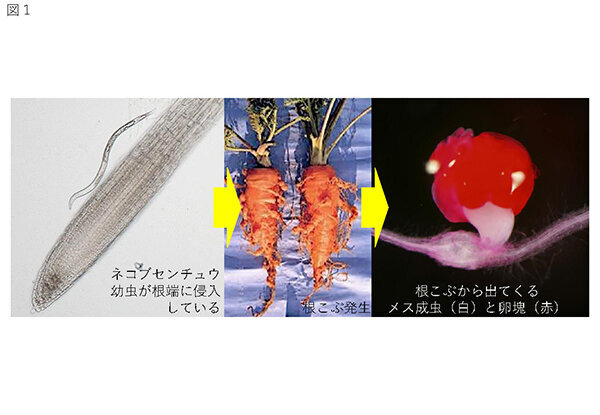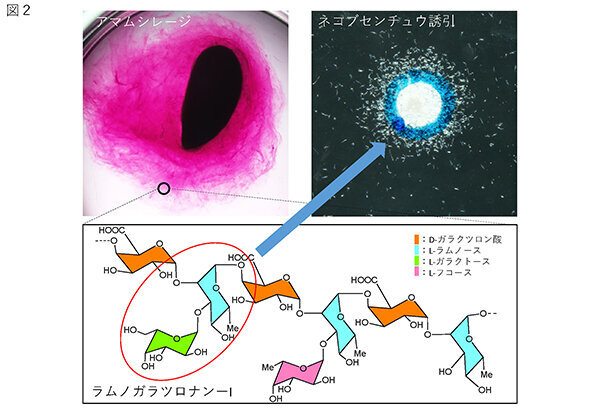研究紹介
Plant-parasitic root-knot nematodes (RKN, Meloidogyne incognita) are agricultural pests that infect many crop plants and cause significant economic losses. Infective RKN juveniles migrate in the soil to seek out the roots of suitable host plants to infect, which they then invade and form specialized feeding organs call root-knots (Fig.1). RKN are known to find suitable hosts through chemotaxis, by sensing compounds secreted by the host's roots, although the identities of such chemo-attractants remain to be deciphered. We discovered that RKN are attracted to the seed coat mucilage, a complex mixture of gelatinous cell wall carbohydrates, secreted by flaxseeds (Linum usitatissimum). Despite the fact that seed coat mucilage synthesis is common among angiosperms, their biological relevance remains unclear to date. Based on analyses done after purification, this mucilage-derived chemo-attractant is likely rhamnogalacturonan-I (a type of cell wall pectin polymer) (Fig.2). In particular, the galactose molecules that are conjugated to pectin polymers are essential for attracting RKN, as altering the structure or changing the chirality of the galactose molecules abolish attraction. Interestingly, nematodes other than RKN do not appear to show chemotactic behavior toward flax mucilage, suggesting this may be a trait unique to RKN. This research highlights the specificity of chemical signal perception by nematodes. Recently the Sawa laboratory has identified several cell wall carbohydrates that mediate nematode chemotaxis; this opens novel opportunities to develop strategies to reduce RKN infections in agriculture.
植物感染性ネコブセンチュウ(Meloidogyne incognita、以下線虫)は多数の農作物に感染し、経済的損害を引き起こすため重要な農業害虫として知られている。線虫の幼虫は土壌内を移動し適切な宿主植物を発見、侵入し、感染した後で根こぶという摂食器官形成を誘導する(図1)。線虫は走化性行為を利用し、植物の根からの分泌物を感知して適切な宿主を探すことが知られているが、その誘引物質の正体はまだあまり明らかになっていない。本研究は、線虫はアマ(Linum usitatissimum)種子が分泌するムシレージに誘引されることを発見した。多くの被子植物種子はゲル状細胞壁多糖類の種皮ムシレージを分泌することが知られているが、現時点で自然環境においてムシレージの役割が明らかになっていない。精製後の分析結果によって、このムシレージ由来の線虫誘引物質はラムノガラツロナン-I(細胞壁多糖類ペクチンの一種)だと考えられる(図2)。特に、ラムノガラツロナン-Iポリマーと繋がっているガラクトース側鎖分子は線虫誘引に不可欠であり、ガラクトース側鎖の構造又はキラリティーを変更した場合、線虫誘引活性が大幅に減少する。興味深いことに、ネコブセンチュウ以外の線虫はアマムシレージに誘引されないことから、アマムシレージ感知はネコブセンチュウのみに保存された特徴かもしれない。本研究はネコブセンチュウのシグナル伝達物質感知の高い特異性を証明できた。澤研究室は他の線虫走化性に影響を与える細胞壁多糖類を発見したことから、これらの結果に基づいて細胞壁を用い、新しい線虫退治対策の開発などの農業応用も期待している。
